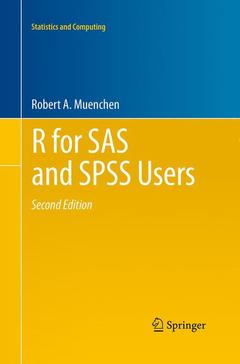Description
R for SAS and SPSS Users (2nd Ed., Softcover reprint of the original 2nd ed. 2011)
Statistics and Computing Series
Author: Muenchen Robert A.
Language: EnglishPublication date: 08-2016
Support: Print on demand
Publication date: 07-2011
686 p. · 15.5x23.5 cm · Hardback
Description
/li>Contents
/li>Biography
/li>Comment
/li>
R is a powerful and free software system for data analysis and graphics, with over 5,000 add-on packages available. This book introduces R using SAS and SPSS terms with which you are already familiar. It demonstrates which of the add-on packages are most like SAS and SPSS and compares them to R's built-in functions. It steps through over 30 programs written in all three packages, comparing and contrasting the packages' differing approaches. The programs and practice datasets are available for download.
The glossary defines over 50 R terms using SAS/SPSS jargon and again using R jargon. The table of contents and the index allow you to find equivalent R functions by looking up both SAS statements and SPSS commands. When finished, you will be able to import data, manage and transform it, create publication quality graphics, and perform basic statistical analyses.
This new edition has updated programming, an expanded index, and even more statistical methods covered in over 25 new sections.
Robert A. Muenchen is the manager of the Statistical Consulting Center at the University of Tennessee and has 28 years of experience as a consulting statistician. He has served on the advisory boards of SPSS Inc. and the Statistical Graphics Corporation.
Uses clear, step-by-step demonstrations of every concept
Uses SAS/SPSS terminology in narrative, Table of Contents, Index and Glossary
Demonstrates which of over 5,000 add-on packages give the most SAS/SPSS-like output
Includes supplementary material: sn.pub/extras
These books may interest you

R for Stata Users 232.09 €




